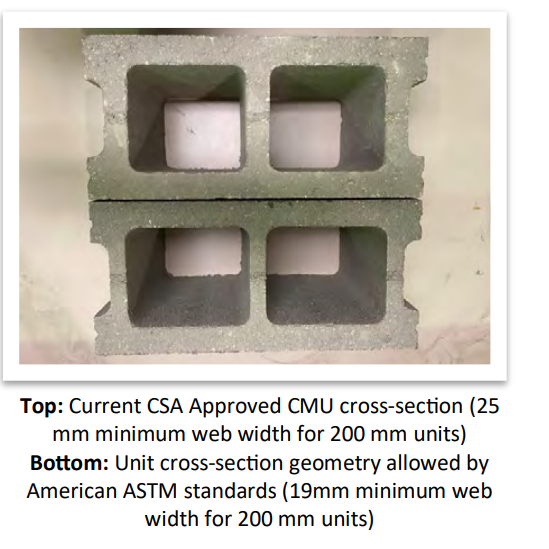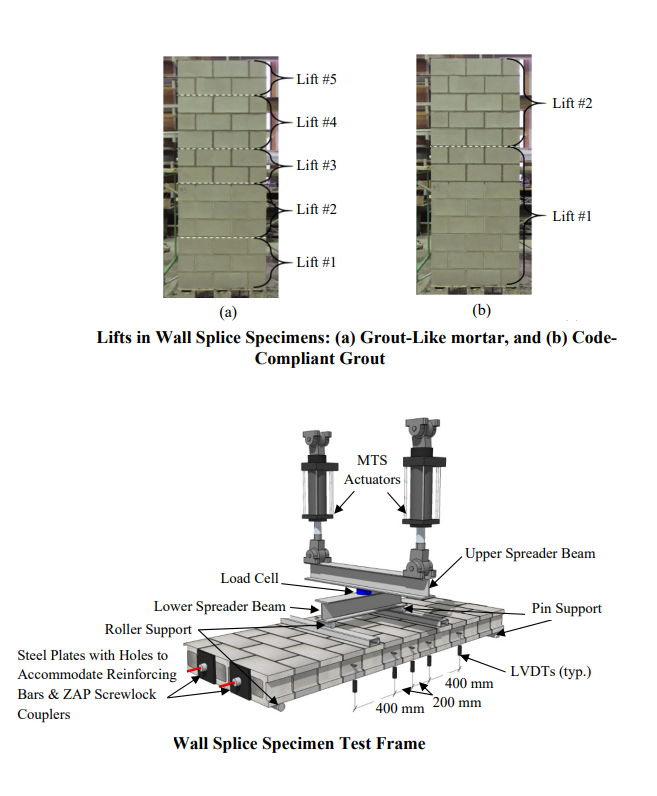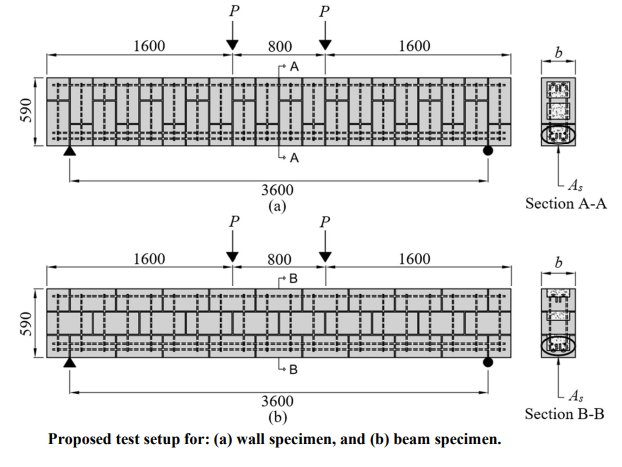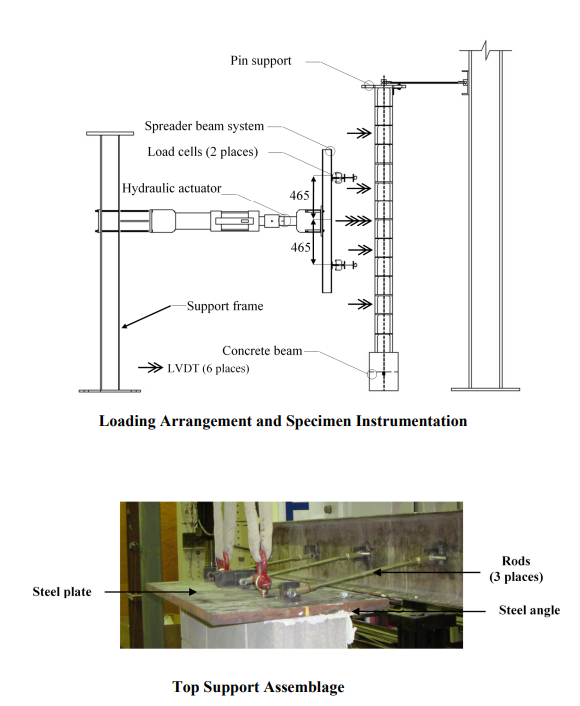CMDC has worked in collaboration with Lisa Feldman, Bruce Sparling, Leon Wegner, and Mohamed Boulfiza from the University of Saskatchewan.
Supporting Innovation through Research Partnerships
Leon Wegner
Work has been conducted on the following projects:
Masonry Unit Geometry
Project Summary:
Hollow concrete masonry units manufactured according to the requirements of CSA A165.1, and installed according to common practices and applicable codes and standards in Canada, have a long history of acceptable performance. However, until recently, little effort had been focused to optimizing the geometric properties of the masonry units to balance performance with other aspects of production and installation (e.g., decreasing the weight of the units, facilitating grout flow within grouted masonry, etc.).
The goal of this study is to examine the effect of variations in the geometric properties of hollow concrete masonry units which have recently been introduced in the U.S. The project includes testing of grouted and ungrouted masonry prisms, and larger masonry assemblages, constructed from units with reduced web thickness and reduced web height.

Recent NAMC Articles:
Heide, M., and Feldman, L.R. (2023, June). “Influence of Web Geometry on Concrete Masonry Walls Subject to Out-of-Plane Loading.” In Proceedings of the Fourteenth North American Masonry Conference. Paper presented at the 14th North American Masonry Conference, Omaha, Nebraska (pp. 89-98). Longmont, CO: The Masonry Society.
Recent Technical Publications:
Chhetri, Nitesh, and Lisa R. Feldman. “Impact of Concrete Masonry Unit Geometry on Masonry Assemblage Strength,” Canadian Journal of Civil Engineering, published online as a first-look article, (2023).
Select Theses and HQP:
Nitesh Chhetri: https://harvest.usask.ca/handle/10388/14185
Development of Bond for Masonry Reinforcement
Project Summary:
Bond between reinforcing bars and the cementitious materials used in conventional concrete block masonry is required for the assemblage to perform satisfactorily. Dr. Feldman’s research on the bond of masonry reinforcement allows designers to reduce conservatism in design while maintaining a high degree of safety. A lack of recent research on this topic has led discrepancies between Canadian and USA standards, and possible over-conservatism, when calculating the required development and splice lengths.
This project applies lessons learned in the reinforced concrete industry to reinforced masonry construction through a comprehensive testing and analysis programme.

Select Journal Articles:
Kisin, Aleksandar, and Lisa R. Feldman. “Corrective Measures for Noncontact Splices in Concrete Block Masonry.” ACI Structural Journal 112, no. 4 (2015).
Kelln, Roanne D., and Lisa R. Feldman. “Bar size factors for lap splices in block walls subjected to flexure.” Canadian Journal of Civil Engineering 42, no. 8 (2015): 521-529.
Select Theses and HQP: :
Aleksandar Kisin: https://harvest.usask.ca/handle/10388/ETD-2014-04-1497
Denise Sanchez Contreras: https://harvest.usask.ca/handle/10388/ETD-2014-04-1529
Roanne Kelln: https://harvest.usask.ca/handle/10388/ETD-2014-08-1663
Resistance of Masonry Assemblages
Project Summary:
A recent study of Canadian and U.S.A. masonry design standards has revealed many differences in the approach and requirements including the engineering design of beams and slender walls, and the determination of compressive strength. For example, in Canada, the design of masonry beams is made challenging because of the lower strength that is allowed to be attributed to masonry subjected to horizontal compression (compression across the vertical head joints).
The testing series includes comparing the performance of identically reinforced beams with the masonry units being laid horizontally or stacked. ASTM and CSA compression test methods for masonry assemblages, including the dimensions of the test specimens, are also compared.
This project is part of a larger effort to harmonize masonry design standards between Canada and the U.S.A to help save costs and promote trade on both sides of the border.

Recent CMS Articles:
Select Journal Articles:
Vachon, Thomas C.J., and Lisa R. Feldman. “A Reassessment of the CSA S304 Chi-Factor for Design of Reinforced Concrete Masonry Members: Large-Scale Experimental Investigation,” Canadian Journal of Civil Engineering 50, no. 7 (2023): 621-632.
Select Theses and HQP:
Ting Hin (Gordon) Chui: https://harvest.usask.ca/handle/10388/14055
Thomas Vachon: https://harvest.usask.ca/handle/10388/14334
Cold Weather Masonry Construction
Project Summary:
The Canadian climate poses special challenges for masonry construction during the winter months. Current standards require masonry works to be maintained at a temperature above freezing for a minimum of 48 hours after construction to allow initial curing of the mortar. In winter, ensuring an adequate ambient temperature is maintained (heating of construction enclosure) during this initial curing time poses a logistical challenge, and increases energy usage (and GHG emissions) and construction costs.
The current study explores the conditions under which modern antifreeze additives may be used with masonry mortars to decrease the required heating time of masonry construction works during the winter months in cold climate regions.
Select Journal Articles:
Saha, Ouafi, Moh Boulfiza, and Leon D. Wegner. “Behavior of Masonry Mortar Containing a Non-Harmful Antifreeze Admixture.” TMS Journal 37, no. 1 (2019): 1 – 10.
Select Theses and HQP: :
Ouafi Saha: https://harvest.usask.ca/handle/10388/12384
Unbonded reinforcement
Project Summary:
Reinforcing masonry assemblages is typically achieved by introducing bars in the hollow cells of concrete masonry units and bonding that reinforcement to the masonry using masonry grout. However, many of the benefits of a reinforced masonry wall can be achieved without bonding through a grouted connection if the reinforcement is prestressed and connected at the top and bottom of the wall. Unbonded prestressed reinforcement is regularly used in reinforced concrete construction (e.g., for long bridge girders), but is seldom seen in masonry construction.
This research project explored the potential of using lightly prestressed masonry walls with unbonded reinforcement to reduce the weight and construction cost of interior reinforced masonry partition walls.

Select Journal Articles:
Miranda, Henry P., Lisa R. Feldman, and Bruce F. Sparling. “Proof of concept investigation of unbonded reinforcement in concrete block masonry.” Canadian Journal of Civil Engineering 45, no. 11 (2018): 936-946.
Select Theses and HQP:
Miranda Henry: https://harvest.usask.ca/handle/10388/11981



